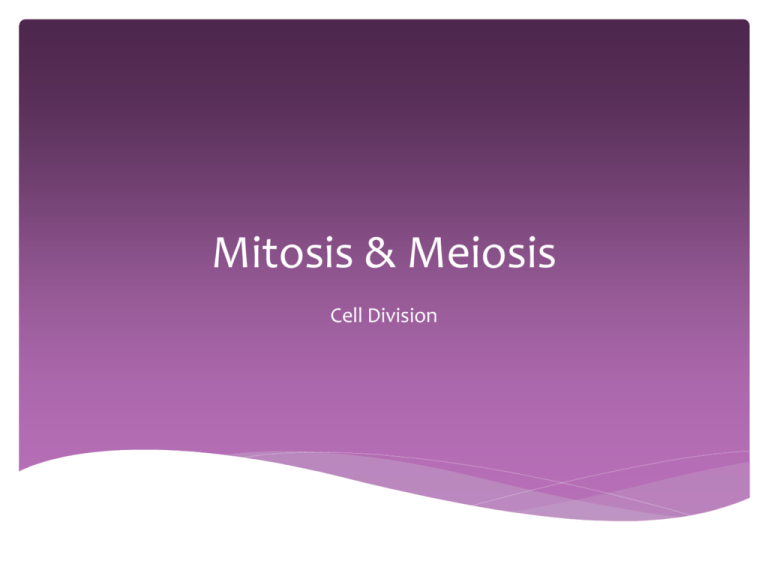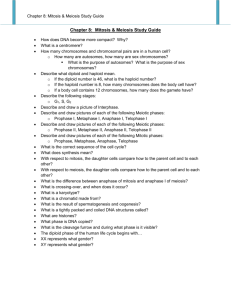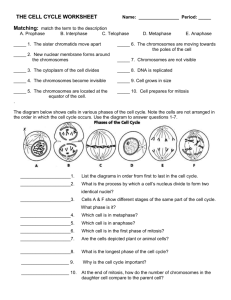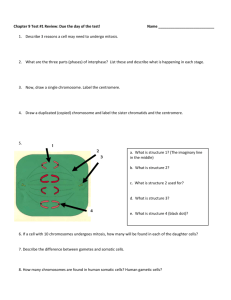Mitosis & Meiosis - Ms. Gordon's online classroom
advertisement

Mitosis & Meiosis Cell Division Why? Purpose… Standard: Analyze and interpret data on the processes of DNA replication, transcription, translation, and gene regulation, and show how these processes are the same in all organisms (2.7b) Objective: SWBAT differentiate between the processes of mitosis and meiosis by diagraming each process with 80% accuracy Cell Cycle What is mitosis? Mitosis is a part of the cell cycle process by which chromosomes in a cell nucleus are separated into two identical sets of chromosomes, each in its own nucleus. Mitosis Notes Document Camera Worksheet & Skeleton Worksheet Meiosis In meiosis, DNA replication is followed by two rounds of cell division to produce four daughter cells with half the number of chromosomes as the original parent cell. Go to my website http://faculty.stcc.edu/BIOL102/Lectures/lesson9/step bystep.htm Interphase I Similar to mitosis interphase. Chromosomes replicate (S phase). Each duplicated chromosome consist of two identical sister chromatids attached at their centromeres. Centriole pairs also replicate. Interphase I Nucleus and nucleolus visible. chromatin nuclear membrane cell membrane nucleolus Meiosis I (four phases) Cell division that reduces the chromosome number by one-half. four phases: a. prophase I b. metaphase I c. anaphase I d. telophase I Prophase I Longest and most complex phase. 90% of the meiotic process is spent in Prophase I Chromosomes condense. Synapsis occurs: homologous chromosomes come together to form a tetrad. Tetrad is two chromosomes or four chromatids (sister and nonsister chromatids). Prophase I - Synapsis Homologous chromosomes sister chromatids Tetrad sister chromatids During Prophase I “Crossing Over” occurs. Crossing Over is one of the Two major occurrences of Meiosis (The other is Non-disjunction) During Crossing over segments of nonsister chromatids break and reattach to the other chromatid. The Chiasmata (chiasma) are the sites of crossing over. Crossing Over creates variation (diversity) in the offspring’s traits. nonsister chromatids Tetrad chiasmata: site of crossing over variation Question: A cell containing 20 chromosomes (diploid) at the beginning of meiosis would, at its completion, produce cells containing how many chromosomes? Answer: 10 chromosomes (haploid) Question: A cell containing 40 chromatids at the beginning of meiosis would, at its completion, produce cells containing how many chromosomes? Answer: 10 chromosomes Prophase I spindle fiber aster fibers centrioles Metaphase I Shortest phase Tetrads align on the metaphase plate. INDEPENDENT ASSORTMENT OCCURS: 1. Orientation of homologous pair to poles is random. 2. Variation 3. Formula: 2n Example: 2n = 4 then n = 2 thus 22 = 4 combinations Metaphase I OR metaphase plate metaphase plate Anaphase I Homologous chromosomes separate and move towards the poles. Sister chromatids remain attached at their centromeres. Anaphase I Telophase I Each pole now has haploid set of chromosomes. Cytokinesis occurs and two haploid daughter cells are formed. Telophase I Meiosis II No interphase II (or very short - no more DNA replication) Remember: Meiosis II is similar to mitosis Prophase II same as prophase in mitosis Metaphase II same as metaphase in mitosis metaphase plate metaphase plate Anaphase II same as anaphase in mitosis sister chromatids separate Telophase II Same as telophase in mitosis. Nuclei form. Cytokinesis occurs. Remember: four haploid daughter cells produced. gametes = sperm or egg Telophase II DOL Graphic organizer comparison sheet Homework Mitosis & Meiosis Flipbook






